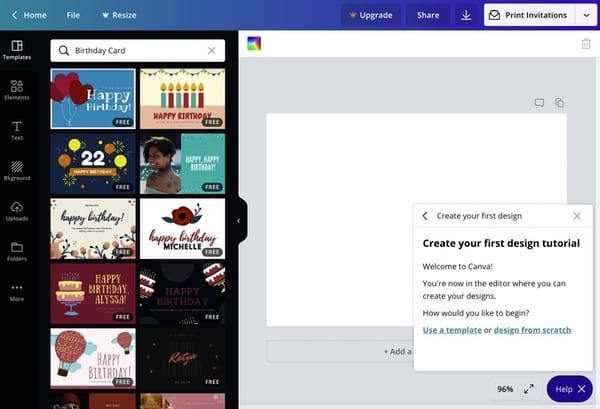Onboarding for a website is to support the user (or the user) to handle the different features of the site.
Onboarding is often set up after the connection of a user to the website to explain the different features of the site. This is the case of many SaaS (software-as-a-service).
Whether for theintegration into a new job (by teams, by management, by the company), or the discovery of a mobile application, this way of designing and preparing the first relationship with the unknown must make it possible to improve the experience of the persons concerned, and therefore facilitate their integration. Let's take a closer look at what's going on on a website.
Is the onboarding of a website mandatory?
The implementation of an onboarding on a website is not systematically necessary. In reality, it all depends on the richness and complexity of the proposed interface.
What sites requires onboarding?
There is obviously no question of setting up onboarding on a showcase site or an e-commerce site. Onboarding is reserved for sites that offer complex tools or features like SaaS.
When a site or an application has many features, sometimes invisible at first glance, or offers innovative uses, onboarding becomes a strategic lever to help the user to handle the tool quickly and effectively.
Do without onboarding thanks to the UX
However, in theory, a web interface thought according to the fundamental principles of UX Design (simplicity, clarity, prioritization of information, accessibility) should be able to do without it.
An intuitive interface, where each element has a logical place and where actions seem natural to the user, limits itself the need for additional support. The ideal is therefore to design experiences where the user intuitively understands how to navigate and interact, without feeling the need to be guided.
Onboarding then becomes a pragmatic response: it is there to compensate for the necessary complexity of a rich interface, but it must never become a crutch for a bad design.
Why is a site onboarding important?
Onboarding plays a decisive role in the first impression that a user of your website will be made. This discovery phase, located between arrival on the site and its regular use, largely conditions the desire – or not – to continue navigation.
Good onboarding reduces frustration linked to novelty: it guides, reassures and facilitates handling. In a few moments, the user must understand what the site offers, how he can achieve his goal, and why he has an interest in staying rather than going to look elsewhere.
Conversely, bad onboarding, or its absence on complex interfaces, can generate rapid confusion and abandonment. The user, lost or poorly informed, may leave the site without having entered his added value.
Clearly, onboarding is important because it:
- Facilitates understanding and navigation from the first moments.
- Enhances the offer and functionalities of the site.
- Reduces the risk of premature abandonment.
- Contributes to installing a relationship of trust and satisfaction.
Well thought out, onboarding transforms a simple visitor into an active user, and sometimes into a loyal customer. It is therefore a key step to optimize the user experience and maximize conversion.
How to set up onboarding?
Setting up an effective onboarding on a website requires thinking about simplicity, utility and discretion. The objective is to support without weighing down the user experience. Here are the key steps to get there.
1. Understand user needs and expectations
Before designing an onboarding course, it is essential to identify who your users are, which they seek to accomplish on your site and what points could be problematic. This analysis will make it possible to target the moments when support is necessary.
2. Define a clear objective
Each onboarding must answer a simple question: what should or successful user know or succeed after this phase? Whether discovering a flagship feature, finalizing an inscription or understanding the operation of a service, the objective must be precise to avoid overloading the user unnecessarily.
3. Choose the right support format
There are several formats to set up onboarding:
- Interactive tutorials: a series of aid bubbles that appear as the navigation progresses.
- Start -up checklist: a simple list of steps to make to take charge of the site.
- Contextual messages: popups or infobulles that appear at the right time depending on the use of the user.
- Video or animated guides: a quick presentation of the main features.
- Chatbots and virtual assistants: to guide the user in a personalized way.
The choice of format will depend on the complexity of your interface and the preferences of your users.


4. Stay progressive and non-intrudent
Successful onboarding is often invisible. He accompanies the user without interrupting his exploration. It is advisable to:
- Limit strict necessary assistance messages.
- Let the user choose whether or not to follow onboarding.
- Provide options to close or replay onboarding at any time.
5. Measure and optimize continuously
Finally, like any element of the user experience, onboarding must be tested and optimized regularly. Analyze behavior (abandonment rate, interaction time, feedback) to identify what works and what can be improved.
Set up onboarding on your site
Establishing effective onboarding cannot be improvised. This requires a good knowledge of your users, a mastery of good UX practices, and a real technical integration work.
To set up onboarding on your website, start by analyzing the use of your users and collect feedbacks.
- Are some features not used?
- Do internet users complain about certain features?
To go further, call on a UX designer or a web developer on the freelance Codeur.com to help you in your onboarding strategy.
